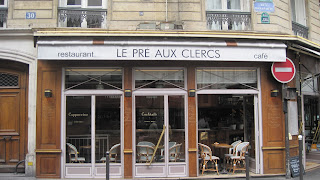The Cafe and Bar culture for the expatriates of the 20s in Paris took on many roles. Though Hemingway enjoyed the night life, albeit not as much as Fitzgerald, he was a dedicated writer and took to cafes where he preferred to write. Many other counterparts such as Joyce, Ford Madox Ford, and Fitzgerald followed suit, and if they fell asleep at the table, the waiters were instructed not to wake them up.
 |
| [Montparnasse July 2012] |
 |
| [July 2012] |
The artistic centers on the Left Bank, which the Lost Generation helped to establish its artistic reputation, were the arrondissements of the 6th and the 5th, Saint Germain des Pres and the Latin Quarter, respectively. In the 6th arrondissement lies Boulevard du Montparnasse, a street lined with cafes such as Le Rotonde and La Closerie de Lilas, where Stein, Hemingway, Fitzgerald, Matisse, Sartre, and Picasso dined and shared creative and intellectual conversation at a time when the neighborhood was renowned for its Bohemian vibe. Hemingway also refers to a mysterious cafe on Boulevard Saint Michel in A Moveable Feast, which is located in the Latin Quarter, another popular neighborhood these artists hung out.
 |
| [Blvd St. Germain des Pres July 2012] |
 |
| [July 2012] |
 |
| [July 2012] |
 |
| [July 2012] |
Right up the street a few blocks sits Boulevard Saint Germain des Pres in the heart of the 6th arrondissement, where other famous meeting grounds for the Lost Generation were Brasserie Lipp, Les Deux Magots, and Cafe de Flore. With such a highly opinionated group of artists, it is no wonder that debates were heated and passionate, and fueled by intelligence or more often, alcohol. Ideas--creative as well as intellectual--rose to the surface, and were dissected, mused, and philosophized. They probably engaged in these heated discussions not only over their respect writing or painting they were working on, but also the politics of the time. Though after the First World War, French society was so exhausted, in a literal and figurative sense, that they rigorously strove for a more leisurely life to rid the terrors of the war with debauchery and joy, hoping WWI was “der des ders” (last of the last); yet this could only be viewed as a fantasy, and the intellects of the Lost Generation--while they partook in this lifestyle--knew it could not last. Heated political discussions they probably had revolved around the rising nationalism in Germany, Northern Africa, Japan and other parts of the world and their tensions with democracies that could potentially spur another world war--which as we all know, did. Interestedly, Dali was part of a Surrealist artist group with Picasso, but was kicked out by the group’s mentor, Andre Breton, rejecting Dali for his fascination with Fascism. This sort of closed-mindedness was surely a rarity in not only a city, but a group of expatriates, who flocked to the liberally and politically advanced Paris for that very reason of speaking openly to an attentive audience without judgment.
 |
| [July 2012] |
On the whole, these debates fueled by passion and opposing viewpoints probably did not last long, as they again masked themselves with the distractions of debauchery and incessant partying. Drinking copious amounts of alcohol during the day was not uncommon, but by the night, it was all but certain. Members of the Lost Generation attended soirees, cabarets, staying out to all hours of the night. Their mounting excesses, most easily exemplified by Fitzgerald’s alcoholic reputation, is in part the reason why their other mentor author Ezra Pound--albeit less influential than Stein--moved to Italy in the coming years. It is also important to note that these lavish parties the Lost Generation frequented were often hosted by wealthy Parisian socialites, who invited these artists to their parties for entertainment, artistic culturing, support, and overall amusement; a tradition that dates back all the way to the Middle Ages where jesters where brought to the court for entertainment value. Of course, these artists were much more respected and even applauded for their innovated contributions to literature and art, it still remains an interesting correlation that must be noted. At these parties, bars, or cafes, the Lost Generation drank, and drank they did. “In many ways, living in the fast lane as they were, this ‘Lost Generation’ was hell-bent on self-destruction, more than amply living up to its adopted name” (Mills).


































